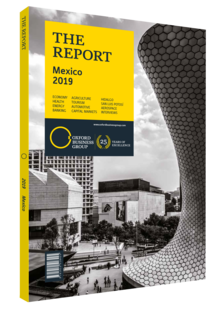Fuel storage capacity set to increase as natural gas distribution networks grow in Mexico
In addition to growing the transport network, increasing storage capacity and addressing fuel theft are priorities in the midstream energy segment. To this end, since the 2013 energy reform the government has commissioned work by companies such as Canadian firms TC Energy and ATCO to expand the natural gas network to keep up with rising demand and supply deficits in the south and south-east of the country.
Natural Gas Network
According to the Ministry of Energy (Secretaría de Energía, SENER), the natural gas pipeline system stood at 15,986 km in 2018, compared to 11,347 km in 2012. In 2019 another 2882 km worth $4.4bn is scheduled to come on-line. Connectivity is strong nationwide, with the exception of some areas in Oaxaca and Chiapas, as well as a few parts of the southern Yucatán Peninsula.
To address this, SENER is currently laying the 247-km Jáltipan-Salina Cruz pipeline to link Oaxaca with Veracruz for an undisclosed amount. The 855-km Ramones-Cempaola line connecting Nuevo León with Veracruz is scheduled for the 2020-24 timeframe at an investment of roughly $1.98bn.
SENER told OBG that the ministry will focus on optimising the natural gas system and expanding the network in the south of the country, which will present opportunities for private investment. While the goal is to improve gas transport so it reaches more places effectively, the government will likely need private players to step in and help with funding and execution.
Mexico’s midstream network is concentrated in the centre and north-east of the country. Indeed, the bulk of the system is divided into the Sistema Norte and the Sistema Sur-Golfo-Centro-Occidente, which are connected to refineries and ports such as Minatitlán and Tula in the central-south region and Madero Cadereyta in the north-east. There is also a line that pipes in US fuel from the El Paso-Ciudad Juárez border point. Independent natural gas systems also exist in the states of Baja California, Sonora, Sinaloa and Yucatán.
Storage
Holding gas and petrol is an equally important midstream activity, yet 73 storage and distribution terminals of the state oil company Petróleos Mexicanos (Pemex) covered only 3.4 days worth of fuel demand at end-2018, compared to 25 days in the US, according to a report by the Oil Price Information Service. “Storage is fundamental to energy security in Mexico. Whoever manages to store large amounts of energy in small spaces will have a clear advantage in the midstream segment,” Jose Miguel Rodríguez, managing director of energy solutions provider Abent 3T, told OBG.
The dynamic is changing, however, as projects with 2020 completion dates are expected to bring 15.5m barrels worth of storage capacity to the scene – almost doubling the land storage of Pemex. A total of 63 projects were being tracked by SENER as of 2018, and if all come to fruition, total new capacity will be more than 45m barrels. A June 2019 report by S&P Global Platts echoes this figure, citing 70 storage projects for a total investment of $4.6bn.
Fuel Theft
One major risk in Mexico’s midstream business is the prevalence of fuel theft by organised crime syndicates. The value of stolen product is significant: Pemex lost an estimated $2.6-3.7bn in sales in 2018 out of a total of $76bn. The situation seems to be improving, with stolen fuel losses reported at $79m in the first quarter of 2019, compared to $368m a year prior. The government has increased military presence in pipeline areas, and in January 2019 Pemex shut off several key gasoline lines and rerouted the fuel in tanker trucks. The logistics were poorly coordinated, however, and caused shortages at pumps around the country, which led to citizen protests. Furthermore, Arturo García Bello, energy and natural resources partner at Deloitte México, told OBG that while this practice saved money from fuel theft, savings were offset against the increased cost of moving fuel via tanker trucks. Therefore, new solutions will have to be found to adequately address this ongoing problem.
You have reached the limit of premium articles you can view for free.
Choose from the options below to purchase print or digital editions of our Reports. You can also purchase a website subscription giving you unlimited access to all of our Reports online for 12 months.
If you have already purchased this Report or have a website subscription, please login to continue.

